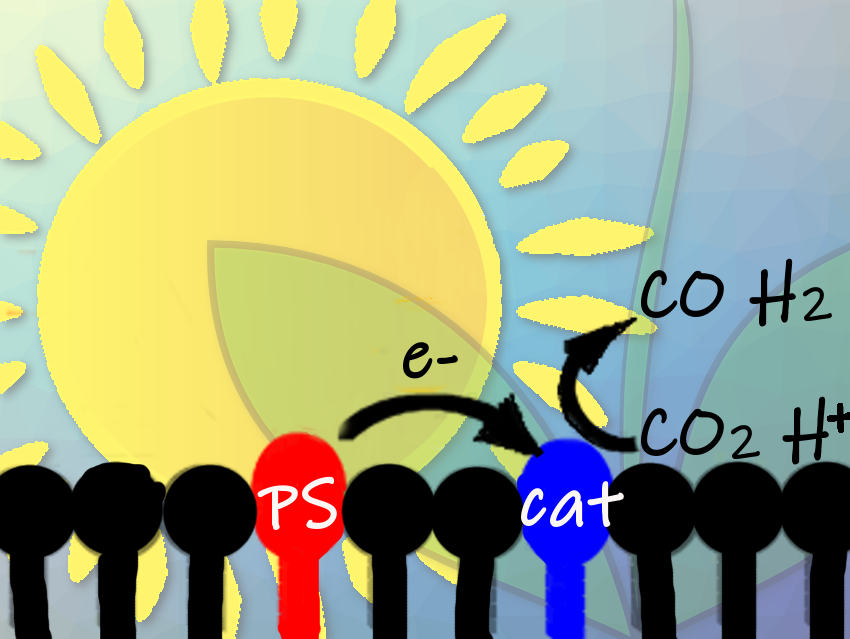Photosynthesis is one of the most complicated, yet essential processes for life on Earth. It combines two separate reaction sequences, the light and the dark reaction. Artificial photosynthesis often focuses on only one of them—either creating energy equivalents from photons or reducing carbon dioxide using a catalyst and electrons. To date, more direct processes have not proved efficient enough to work on a large scale.
In a collaborative work, Leif Hammarström, Uppsala University, Sweden, Erwin Reisner, University of Cambridge, UK, and colleagues have identified a method for accelerating photocatalysis, making the whole process more efficient. Put simply, they used the natural environment of photoreactions: the membranes.
Light and Dark Reactions
Natural photosynthesis brings together a huge variety of biophysical and biochemical reactions. First, in the light reaction, incoming photons trigger an electronic gradient across a membrane—the thylakoid membrane in chloroplasts—to produce reductive agents and energy equivalents. In a second reaction, known as the dark reaction, carbon dioxide molecules are reduced in the cytoplasm in a number of steps, ultimately giving carbohydrates, the plant’s energy stores.
For the last century, scientists have found many ways to reproduce at least parts of this process. Light energy can be converted to electric current, mainly by using semiconductors, and carbon dioxide can be reduced using electric current and/or catalysts. Scientists usually either have pigments sitting on electrodes to convert photons to electric charge, or they use homogeneous systems where water-soluble photosensitizers activate catalysts for CO2 reduction in a process controlled entirely by diffusion.
Membranes Hold the Key
Moving away from these partial models, the team refocused on membranes. By examining the natural thylakoid membrane processes, they proposed that redox partners would find each other more easily if they sat nearby in assembled components.
To achieve a membrane-bound photoreduction system, the researchers simply added alkyl chains to both photosensitizer and catalyst, giving them an affinity for the membrane. The photosensitizer was a ruthenium bipyridine complex, the catalyst a porphyrin cobalt complex with the porphyrin ligands also carrying pyridines. In both cases, the alkyl chains serving as membrane anchors were attached to the pyridines.
A photosensitizer–catalyst system works by combining photoexcitation with electron transfer. The excited photosensitizer pigment scavenges electrons from a sacrificial electron donor, in this case, sodium ascorbate. Transition-metal complexes catalyze carbon dioxide reduction by transferring two electrons received from the photosensitizer to a coordinated carbon dioxide molecule, which then leaves the catalyst as carbon monoxide. The researchers highlight that the catalyst is also activated by the photosensitizer, which makes this porphyrin cobalt complex so effective.
The team went on to set up a liposome-based photocatalytic system. The liposomes were made from a phosphocholine lipid derivative, which forms bilayers, and from a bulky anionic lipid used as a dopant to keep the liposomes separate.
Compact Photocatalytic System
Using a light source that mimicked sunlight, the researchers found the liposome-integrated catalyst system worked much better than the soluble one without the alkyl chains. They reported turnover numbers that were four times higher, as well as much less hydrogen, a byproduct in homogeneous photoreduction reactions.
The team explained the improved performance by the favorable assembling of the pigments and the catalyst in the membrane. Like light-harvesting pigments in natural photosystems, membrane-bound photosensitizers would have longer charge separation lifetimes, and they are closer to their redox partners, thus making electron transfer more likely than in diffusion-based systems.
Interestingly, the researchers’ photosystem also gives photosynthesis a compact form. Shortcutting the light and dark reactions found in nature, it directly combines light sensitization with carbon dioxide reduction. This research also highlights the fact that membrane-bound artificial photosynthesis is still underexplored, and gives hope for the development of even more efficient processes in the future.
- Self-Assembled Liposomes Enhance Electron Transfer for Efficient Photocatalytic CO2 Reduction,
Santiago Rodríguez-Jiménez, Hongwei Song, Erwin Lam, Demelza Wright, Andrea Pannwitz, Shannon A. Bonke, Jeremy J. Baumberg, Sylvestre Bonnet, Leif Hammarström, Erwin Reisner,
J. Am. Chem. Soc. 2022.
https://doi.org/10.1021/jacs.2c01725




